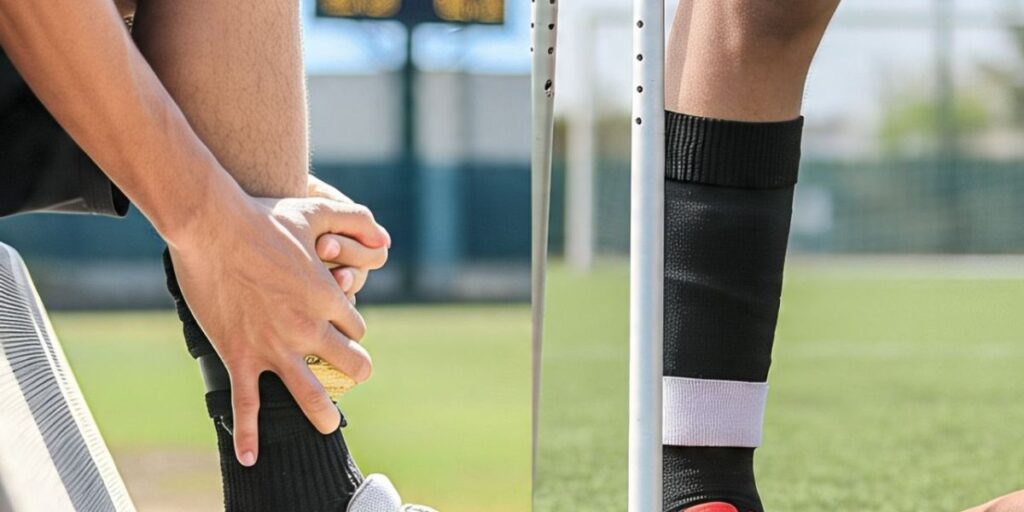It’s easy to confuse a twisted vs sprained vs rolled ankle, especially when the pain strikes suddenly after a misstep. These terms are often used interchangeably, but they don’t always mean the same thing. A twisted ankle refers to any awkward ankle movement that may or may not involve injury. A sprained ankle, however, involves stretched or torn ankle ligaments, typically from an inversion ankle injury. Meanwhile, a rolled ankle often happens when the foot turns inward, straining the outer ligaments. Understanding these differences is important because each type of ankle trauma may require a different approach to care. Getting the right diagnosis helps with faster healing and prevents long-term ankle joint instability.
What Is the Difference Between a Sprained, Twisted, and Rolled Ankle?
A sprained ankle occurs when the ligaments that connect bones in the ankle are stretched or torn. This typically happens when the ankle is twisted or rolled beyond its normal range of motion. On the other hand, a twisted ankle is a more general term that refers to any injury caused by the ankle turning in an unusual way, which may or may not involve ligament damage. A rolled ankle, often used synonymously with a sprained ankle, specifically refers to an injury where the foot rolls inward, causing stress on the outer ligaments.
Understanding these distinctions helps in identifying the appropriate treatment and rehabilitation methods for each type of injury.
Common Causes of Sprained vs. Rolled Ankles
Both sprained and rolled ankles are commonly caused by activities that involve sudden movements or uneven surfaces. Sports like basketball, soccer, and running on trails are frequent culprits. Wearing improper footwear, such as high heels or shoes without proper arch support, can also increase the risk. Additionally, walking or running on uneven ground can lead to these injuries, as the ankle may twist or roll unexpectedly.
Preventing these injuries involves being cautious during physical activities and ensuring that your footwear provides adequate support.
Who Is Most Likely to Get a Sprained or Rolled Ankle?
Anyone can experience a sprained or rolled ankle, but certain groups are at higher risk. Athletes, especially those involved in high-impact sports, are more prone due to the nature of their activities. Individuals with a history of ankle injuries or those with weakened ankle ligaments are also at increased risk. Additionally, older adults may experience these injuries more frequently due to decreased bone density and balance issues.
Taking preventive measures, such as strengthening exercises and proper warm-ups, can help reduce the risk.
Symptoms: How to Know If You Sprained or Rolled Your Ankle
The symptoms of a sprained or rolled ankle can vary depending on the severity of the injury. Common signs include pain, swelling, bruising, and difficulty bearing weight on the affected foot. In more severe cases, there may be a popping sound at the time of injury, and the ankle may feel unstable. It’s important to assess the severity of these symptoms to determine the appropriate course of action.
If you experience significant pain, swelling, or an inability to move the ankle, it’s advisable to seek medical attention promptly.

How Bad Is It? Sprained Ankle Grading Explained
Sprained ankles are classified into three grades based on the severity of the ligament damage:
- Grade 1 (Mild): Slight stretching or microscopic tears in the ligament. Symptoms include mild pain and swelling.
- Grade 2 (Moderate): Partial tearing of the ligament. Symptoms include moderate pain, swelling, and difficulty bearing weight.
- Grade 3 (Severe): Complete tear of the ligament. Symptoms include severe pain, swelling, and instability.
Understanding the grade of the sprain helps in determining the appropriate treatment and recovery plan.
Immediate Care: What to Do Right After a Sprain or Roll
Immediate care for a sprained or rolled ankle involves the R.I.C.E. method:
- Rest: Avoid putting weight on the injured ankle.
- Ice: Apply ice to reduce swelling and numb the pain.
- Compression: Use an elastic bandage to help control swelling.
- Elevation: Keep the ankle raised above heart level to reduce swelling.
Following this method promptly after the injury can aid in the healing process and reduce the severity of symptoms.
When Should You See a Doctor for an Ankle Injury?
It’s important to consult a healthcare professional if you experience severe pain, cannot bear weight on the injured ankle, or notice significant swelling and bruising. A doctor can assess the injury, determine its severity, and recommend appropriate treatment. In some cases, imaging tests like X-rays may be necessary to rule out fractures.
Seeking medical attention ensures proper diagnosis and prevents potential complications.

Long-Term Treatment Options and Recovery Timeline
Treatment for a sprained or rolled ankle depends on the severity of the injury. For mild sprains, rest and home care may be sufficient. Moderate to severe sprains may require physical therapy to restore strength and flexibility. In rare cases, surgery may be necessary to repair torn ligaments.
Recovery time varies:
- Grade 1: 1 to 3 weeks
- Grade 2: 3 to 6 weeks
- Grade 3: 6 to 12 weeks or more
Adhering to the recommended treatment plan and avoiding premature return to activity can help ensure full recovery.
How to Prevent Future Ankle Injuries
Preventing sprained or rolled ankles involves several strategies:
- Strengthening Exercises: Focus on exercises that strengthen the ankle ligaments and muscles.
- Proper Footwear: Wear shoes that provide adequate support and fit properly.
- Balance Training: Engage in activities that improve balance and coordination.
- Warm-Up and Stretching: Always warm up before physical activities and stretch to maintain flexibility.
Implementing these preventive measures can significantly reduce the risk of future ankle injuries.
Final Thoughts: Taking the Right Steps Toward Healing
Understanding the differences between a sprained and a rolled ankle is crucial for effective treatment and recovery. Prompt and appropriate care can lead to a quicker return to daily activities. Always listen to your body, and don’t hesitate to seek medical attention if needed. Taking proactive steps can help you heal properly and prevent future injuries.
Note: This article is intended for informational purposes and should not replace professional medical advice. Always consult with a healthcare provider for concerns about injuries or health conditions.
Ultimate Guide: How to instantly kill toenail fungus
FAQs
Is my ankle sprained, rolled, or twisted?
A sprained ankle involves ligament damage, a rolled ankle usually means the foot turned inward, and twisted is a general term for any awkward ankle movement.
Can you walk on a twisted ankle?
Walking may be possible but can cause more damage; it’s best to rest and assess pain first.
Should I wrap a twisted ankle?
Yes, wrapping helps reduce swelling and supports the ankle during healing.
How long does a twisted ankle heal?
Most twisted ankles heal within 1 to 3 weeks with proper care, but severity can affect recovery time.
Welcome to Heel Tooth! I’m Lee Marvin.

